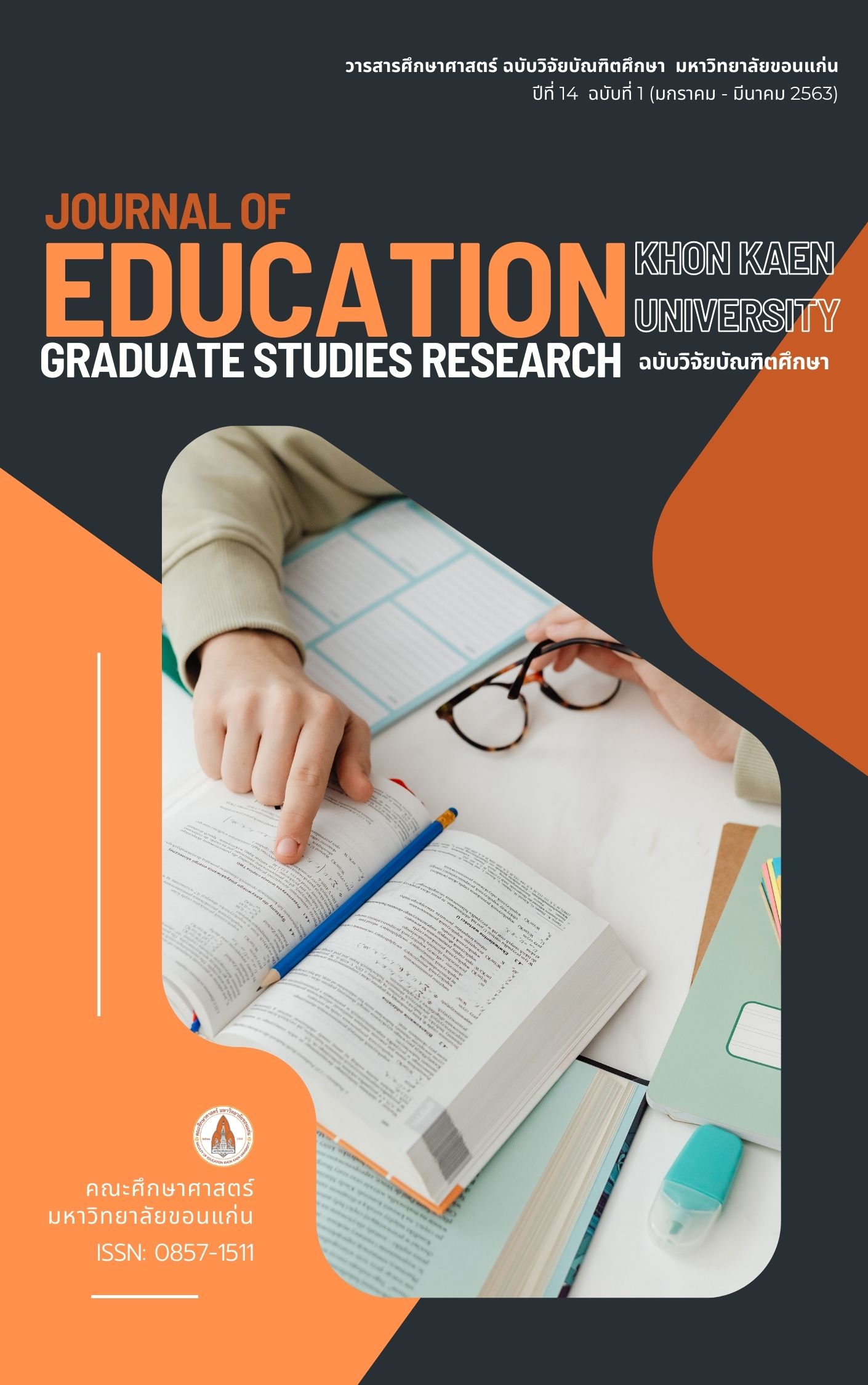Factors Affecting Tactile Pictures Understanding of Students with Visual Impairment in Bangkok Metropolitan Area
Main Article Content
Abstract
The purposes of this research were 1) to study the students with visual impairment’s comprehension of tactile graphics; 2) to study factors affecting students with visual impairment’s tactile graphics comprehension and; 3) to propose the guideline for the production of tactile graphics for students with visual impairment. The sample of this study was 10 high-school students with visual impairment. Instruments used were tactile graphics including: a simple line graph, a 2-line graph, a sphere and a cylinder, a solar system, a map of Southeast Asia; a questionnaire regarding factors affecting tactile graphic comprehension; a time expenditure for touching tactile graphic form; and an observation guideline on the tactile graphic reading behaviors of students with visual impairment.
Results indicated that students with adventitious visual impairment could comprehend tactile graphics 3.21 minutes faster than students with congenital visual impairment. Students with adventitious visual impairment took the average time of 6.40 minutes to comprehend tactile graphics whilst those with congenital visual impairment took average 10.01 minutes. Besides, experiences and practices were essential to the deftness in students with visual impairment’s tactile graphics comprehension.
Results from the observation of students with visual impairment’s tactile graphics reading behaviors showed that; in all 5 tactiles graphics, students would start to explore the graphics by using their right hand in the first reading of the graphics. They would read the graphics from left to right side of the graphics and then right to left. If they could not tell what the particular graphics were, they would use both hands to read the graphics. They would explore the overview of the graphics from top to bottom and left to right. Then, they would read the title of the graphics and explore the details of the graphics again.
Article Details
References
กระทรวงศึกษาธิการ. (2551). พระราชบัญญัติการจัดการศึกษาสำหรับคนพิการ พ.ศ. 2551. กรุงเทพฯ: โรงพิมพ์ชุมนุมสหกรณ์การเกษตรแห่งประเทศไทย.
กระทรวงศึกษาธิการ. (2552). การสังเคราะห์งานด้านการจัดการเรียนร่วมสู่ภาคปฏิบัติเพื่อนำสู่นโยบาย การจัดการศึกษาอย่างมีคุณภาพ สําหรับเด็กและเยาวชนพิการ. กรุงเทพฯ: โรงพิมพ์ชุมนุมสหกรณ์การเกษตรแห่งประเทศไทย.
จันทนา อินสระ. (2556). สื่อภาพนูน “สัตว์หิมพานต์” เพื่อผู้พิการทางสายตา. การประชุมทางวิชาการ การวิจัยทางการศึกษาระดับชาติครั้งที่ 15 ของสำนักงานเลขาธิการสภาการศึกษา. 23-25 มิถุนายน 2556.
จีรพร แผ้วกิ่ง และโสภา อ่อนโอภาส. (2556). รายงานวิจัยย่อยฉบับสมบูรณ์วิถีชีวิตคนพิการทางสายตาในเขตกรุงเทพมหานคร. กรุงเทพฯ: สำนักงานกองทุนสนับสนุนการวิจัย.
ชาย โพธิสิตา (2552). ศาสตร์และศิลป์แห่งการวิจัยเชิงคุณภาพ. (พิมพ์ครั้งที่ 4). กรุงเทพฯ: อมรินทร์พริ้นติ้งแอนด์พับลิชชิ่ง.
บุญธรรม กิจปรีดาบริสุทธิ์. (2540). ระเบียบวิธีการวิจัยทางสังคมศาสตร์. (พิมพ์ครั้งที่ 7). กรุงเทพฯ: ภาคการศึกษาศาสตร์ คณะสังคมศาสตร์และมนุษยศาสตร์ มหาวิทยาลัยมหิดล.
ปัณณ์พัฒน์ จันทร์สว่าง. (2557). ลูกมีความบกพร่องทางการมองเห็น. กรุงเทพฯ: จุฬาลงกรณ์มหาวิทยาลัย.
ปรีชา กลํ่านาค. (2553). นวัตกรรมทางการศึกษา. กรุงเทพฯ: ธารอักษร.
ยุพา มหามาตร. (2551). การสร้างสรรค์งานศิลปะภาพพิมพ์นูนต่ำเพื่อเด็กพิการทางสายตา. วารสารวิจิตรศิลป์, 1(2). 135-151.
รุจิรา อาจหาญ จินตนา จันทร์เจริญ และวีรพันธุ์ ศิริฤทธิ์. (2557). ปัจจัยการบริหารงานฝ่ายกิจการนักเรียนที่ส่งผลต่อคุณภาพโรงเรียนเฉพาะความพิการบกพร่องทางสติปัญญา สังกัดสำนักบริหารงานการศึกษาพิเศษ. วารสารศึกษาศาสตร์ มหาวิทยาลัยขอนแก่น, 37(1), 115-124.
อรัญญา วรชาติอุดมพงศ์. (2558). การจัดการศึกษาสำหรับเด็กที่มีความต้องการพิเศษ. ค้นเมื่อ 25 มกราคม 2562, จาก http://aranyaeec.blogspot.com/
Aldrich, F. K. and Sheppard, L. (2001). Tactile Graphics in School Education: Perspectives from Pupils. British Journal of Visual Impairment, 19(69), 69-73.
Arditi, A., Holtzman, J. D. and Kosslyn, S. M. (1988). Mental Imagery and Sensory Experience in Congenital Blindness. Neuropsychologia, 26(1), 1-12.
Creswell, J. (2009). Research Design: Qualitative, Quantitative and Mixed Methods Approaches. (3rd ed.). Thousand Oaks, CA: Sage.
D’Angiulli, A. (2007). Raised-Line Pictures, Blindness, and Tactile “Beliefs”: An Observational Case Study. Journal of Visual Impairment and Blindness, 101(3), 172-177.
Heller, M. A. (1989). Picture and Pattern Perception in the Sighted and the Blind: The Advantage of the Late Blind. Perception, 18(3), 379-389.
Heller, M. A. (2002). Tactile Picture Perception in Sighted and Blind People. Behavioural Brain Research, 135(1-2), 65-68.
Patton, M. Q. (2002). Qualitative Research and Evaluation Methods. (3rd ed.). Thousand Oaks, CA: Sage.
Russier, S. (1999). Haptic Discrimination of Two-Dimensional Raised-Line Shapes by Blind and Sighted Adults. Journal of Visual Impairment and Blindness, 92(2), 224-235.

